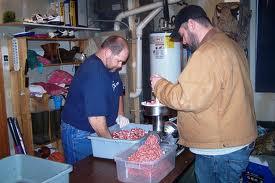Thoughts About Lead Poisoning for Hunters and Their Dinner Guests
 International and domestic studies have shown elevated lead levels in humans consuming large and small game hunted with lead ammunition. Studies prove that regular consumption of game meat in adults and children found elevated blood lead levels compared with background levels, especially among children.
International and domestic studies have shown elevated lead levels in humans consuming large and small game hunted with lead ammunition. Studies prove that regular consumption of game meat in adults and children found elevated blood lead levels compared with background levels, especially among children.
In terms of lead ingestion, risk is dependent on how much lead is consumed and the frequency of exposure; therefore, limiting the total amount of lead exposure reduces harm. Factors that increase dietary lead exposure from spent lead bullet fragments in wild game include:
•The frequency and amount of hunted game that a person consumes.
•The age of the person consuming the meat.
•The degree of bullet fragmentation.
•The path which the bullet enters the wildlife.
•The care with which the meat surrounding the bullet wound is removed
•The use of any acidic treatments of the meat that would dissolve the lead (such as coating the carcass with vinegar or use of acidic marinades in cooking), which can increase exposure.
•Fragmentation that occurs due to the bullet hitting something hard (e.g., bone).
Important Considerations When Processing Your Bounty:
There is expected to be a higher incidence of lead bullet fragments in ground meats than in loins or roasts because meat trimmed away from the bullet channel can contain more fragments. This is because the muscle tissue around the wound channel is not discarded, but rather is used in burger, stews, and sausages. It is recommended that the tissue around the wound channel be removed during food preparation.
Variation in lead concentrations in small animals such as birds is large, most likely due to the shooting skill of the hunter. Birds where the hunter has not destroyed the body in killing it will have less lead exposure when consumed.
When preparing venison, avoiding vinegar and other acidic substances is suggested, as acids can make lead more soluble and therefore more readily absorbed in the body. Also, when processing, minimizing the batching of multiple deer is thought to reduce cross-contamination.
Ways to avoid the problem:
 You could switch to archery! If that is not an option for you consider use of non-toxic ammunition. Currently, the US Fish and Wildlife Service approves the use of 11 types of non-toxic shell-shot with various material compositions. For example shell-shot is available in steel, bismuth, tungsten, and tin. Also, bullets are available in copper and metal alloys. The picture to the left shows he difference when a lead and a copper bullet were fired into a barrell. The copper bullet mushroomed while its lead counterpart shredded during a recent demonstration at Waterloo, Wisc. Gun Club.
You could switch to archery! If that is not an option for you consider use of non-toxic ammunition. Currently, the US Fish and Wildlife Service approves the use of 11 types of non-toxic shell-shot with various material compositions. For example shell-shot is available in steel, bismuth, tungsten, and tin. Also, bullets are available in copper and metal alloys. The picture to the left shows he difference when a lead and a copper bullet were fired into a barrell. The copper bullet mushroomed while its lead counterpart shredded during a recent demonstration at Waterloo, Wisc. Gun Club.
Note:
This information was summerized from "Lead Issues at National Park Service Units:Identifying Potential Sources and Minimizing Exposure" by the National Park Service Office of Public Health

 Looking for accurate information about the EPA RRP rule?
Looking for accurate information about the EPA RRP rule? 


